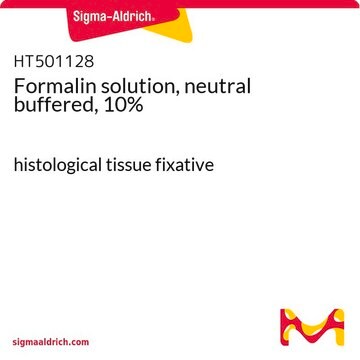Products may be shipped at a different temperature than the recommended long-term storage temperature. If the product quality is sensitive to short-term exposure to conditions other than the recommended long-term storage, it will be shipped on wet or dry-ice. If the product quality is NOT affected by short-term exposure to conditions other than the recommended long-term storage, it will be shipped at ambient temperature. As shipping routes are configured for minimum transit times, shipping at ambient temperature helps control shipping costs for our customers. For more information, please refer to the Storage and Transport Conditions document: https://www.sigmaaldrich.com/deepweb/assets/sigmaaldrich/marketing/global/documents/316/622/storage-transport-conditions-mk.pdf
Kluczowe dokumenty
P6148
Paraformaldehyde
reagent grade, crystalline
Synonim(y):
Polyoxymethylene
Wybierz wielkość
283,00 zł
Wybierz wielkość
About This Item
283,00 zł
Polecane produkty
klasa czystości
reagent grade
Poziom jakości
gęstość pary
1.03 (vs air)
ciśnienie pary
<1.45 mmHg ( 25 °C)
Formularz
crystalline
temp. samozapłonu
572 °F
granice wybuchowości
73 %
mp
120-170 °C (lit.)
gęstość
0.88 g/mL at 25 °C (lit.)
temp. przechowywania
2-8°C
ciąg SMILES
[O-]#[C+H2]
InChI
1S/CH2O/c1-2/h1H2
Klucz InChI
WSFSSNUMVMOOMR-UHFFFAOYSA-N
Szukasz podobnych produktów? Odwiedź Przewodnik dotyczący porównywania produktów
Powiązane kategorie
Opis ogólny
Zastosowanie
produkt powiązany
Hasło ostrzegawcze
Danger
Zwroty wskazujące rodzaj zagrożenia
Zwroty wskazujące środki ostrożności
Klasyfikacja zagrożeń
Acute Tox. 4 Inhalation - Acute Tox. 4 Oral - Carc. 1B - Eye Dam. 1 - Flam. Sol. 2 - Muta. 2 - Skin Irrit. 2 - Skin Sens. 1 - STOT SE 3
Organy docelowe
Respiratory system
Kod klasy składowania
4.1B - Flammable solid hazardous materials
Klasa zagrożenia wodnego (WGK)
WGK 2
Temperatura zapłonu (°F)
Not applicable
Temperatura zapłonu (°C)
Not applicable
Środki ochrony indywidualnej
Eyeshields, Faceshields, Gloves, type P3 (EN 143) respirator cartridges
Wykazy regulacyjne
Wykazy regulacyjne dotyczą głównie produktów chemicznych. Można w nich podawać ograniczoną liczbę informacji na temat produktów niechemicznych. Brak wpisu oznacza, że żaden ze składników nie znajduje się w wykazie. Użytkownik odpowiada za zagwarantowanie bezpiecznego i zgodnego z prawem stosowania produktu.
EU REACH Annex XVII (Restriction List)
Wybierz jedną z najnowszych wersji:
Masz już ten produkt?
Dokumenty związane z niedawno zakupionymi produktami zostały zamieszczone w Bibliotece dokumentów.
Klienci oglądali również te produkty
Produkty
Available Fluorescent in situ hybridization (FISH) procedures, reagents and equipment.
Dostępne procedury, odczynniki i sprzęt do fluorescencyjnej hybrydyzacji in situ (FISH).
Protokoły
Cell staining can be divided into four steps: cell preparation, fixation, application of antibody, and evaluation.
Powiązane treści
Three-dimensional (3D) printing of biological tissue is rapidly becoming an integral part of tissue engineering.
Trójwymiarowe (3D) drukowanie tkanek biologicznych szybko staje się integralną częścią inżynierii tkankowej.
-
How is shipping temperature determined? And how is it related to the product storage temperature?
1 answer-
Helpful?
-
-
How can I determine the shelf life / expiration / retest date of this product?
1 answer-
If this product has an expiration or retest date, it will be shown on the Certificate of Analysis (COA, CofA). If there is no retest or expiration date listed on the product's COA, we do not have suitable stability data to determine a shelf life. For these products, the only date on the COA will be the release date; a retest, expiration, or use-by-date will not be displayed.
For all products, we recommend handling per defined conditions as printed in our product literature and website product descriptions. We recommend that products should be routinely inspected by customers to ensure they perform as expected.
For products without retest or expiration dates, our standard warranty of 1 year from the date of shipment is applicable.
For more information, please refer to the Product Dating Information document: https://www.sigmaaldrich.com/deepweb/assets/sigmaaldrich/marketing/global/documents/449/386/product-dating-information-mk.pdfHelpful?
-
-
What is the difference between formaldehyde and paraformaldehyde?
1 answer-
Paraformaldehyde is the polymeric form of formaldehyde. It is a solid. Formaldehyde is a gas which when dissolved in water gives a formaldehyde solution. Commercially available formaldehyde solutions usually contain 10-15% methanol, which prevents the formaldehyde from forming the polymeric paraformaldehyde.
Helpful?
-
-
How to prepare solutions of Product P6148, Paraformaldehyde?
1 answer-
Paraformaldehyde does not dissolve but rather can be depolymerized in solution. Depolymerized solutions can be prepared in water with heating to 55-60°C. If necessary, further addition of 1-2 drops of a sodium hydroxide solution may be required. Some protocols suggest that paraformaldehyde should be prepared in buffered solutions such as phosphate buffer or PBS at approximately pH 7.
Helpful?
-
-
What is the Department of Transportation shipping information for this product?
1 answer-
Transportation information can be found in Section 14 of the product's (M)SDS.To access the shipping information for this material, use the link on the product detail page for the product.
Helpful?
-
-
How stable are Product P6148, Paraformaldehyde, solutions?
1 answer-
Buffered solutions of 2-4% can be stored protected from light for 2-3 weeks at 2-8°C.
Helpful?
-
-
What is the shelf life of Product P6148, Paraformaldehyde?
1 answer-
The shelf life has not been assigned but guarantee of quality is 1 year from the time of receipt for unopened bottles stored at 2-8 °C. We expect the product to be of good quality for at least 2 years.
Helpful?
-
-
What is the difference between formaldehyde and paraformaldehyde?
1 answer-
Paraformaldehyde is the polymeric form of formaldehyde. Paraformaldehyde is a solid, and formaldehyde is a gas. Formaldehyde solutions consist of formaldehyde gas dissolved in a solvent of some kind.
Helpful?
-
Active Filters
Nasz zespół naukowców ma doświadczenie we wszystkich obszarach badań, w tym w naukach przyrodniczych, materiałoznawstwie, syntezie chemicznej, chromatografii, analityce i wielu innych dziedzinach.
Skontaktuj się z zespołem ds. pomocy technicznej











